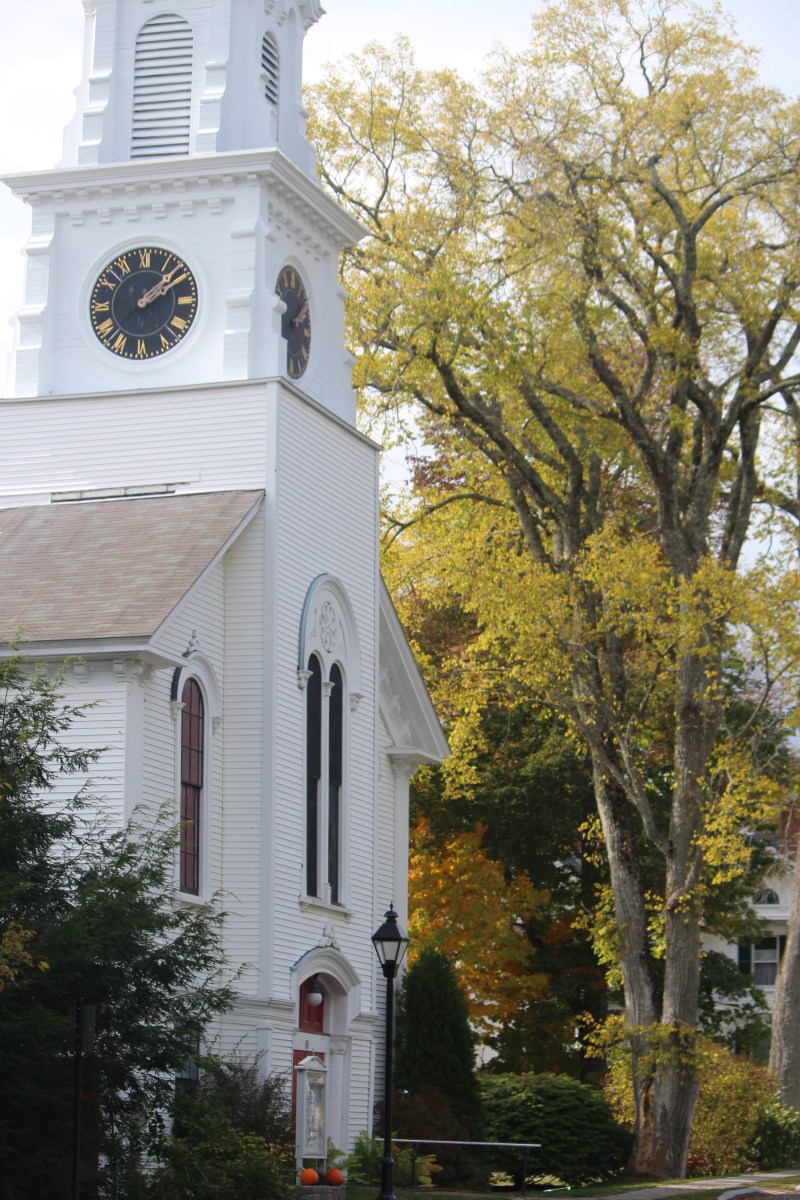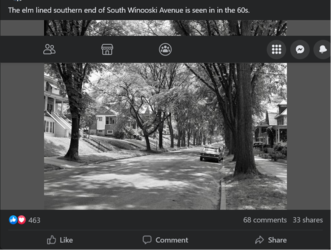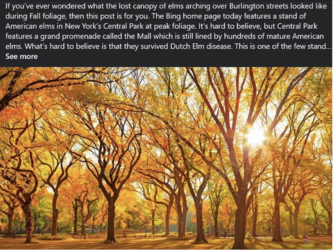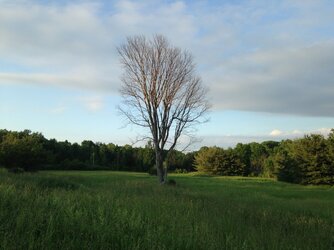My whole life ive heard the old timers talk about how American Elms used to line the streets but that a disease took over and they all died. Is this true? Do American Elms still exist? Anyone here have any stories about seeing these trees back in the day? Did they get a disease and just rot away one day, and why just American Elm? I need to put this family controversy to rest.
Whats up with American Elm disease? Grandpa stories exaggerated?
- Thread starter Jotel me this
- Start date
-
- Tags
- american elm disease
-
Active since 1995, Hearth.com is THE place on the internet for free information and advice about wood stoves, pellet stoves and other energy saving equipment.
We strive to provide opinions, articles, discussions and history related to Hearth Products and in a more general sense, energy issues.
We promote the EFFICIENT, RESPONSIBLE, CLEAN and SAFE use of all fuels, whether renewable or fossil.
You are using an out of date browser. It may not display this or other websites correctly.
You should upgrade or use an alternative browser.
You should upgrade or use an alternative browser.
MongoMongoson
Feeling the Heat
My aunt has a huge American Elm outside her house in the UP of Michigan. The Michigan DNR collected seeds from it because it is apparently very resistant to the Dutch Elm disease. It is still going strong.
I just cut and split some American Elm this last spring.
I just cut and split some American Elm this last spring.
sloeffle
Minister of Fire
I have a bunch in my wood lot. I find that they get to a certain size and then die. I had a pretty good size one near the road and the wonderful Asplundh tree trimmers ( tongue in cheek ) did their usual butcher job of trimming it. A few years later it was dead due to dutch elm. 

Simonkenton
Minister of Fire
My girlfriend bought a nice house in north Atlanta, on Cantrell Road. She had a beautiful elm tree in her yard. The old timers there told her that when the neighborhood was built in 1934, the street was lined with elms, and they were beautiful. But all the elm trees, by 1990, had died except this one. In 1991 that elm tree died. The demise of the elm tree in Georgia is no myth.
peakbagger
Minister of Fire
I grew up in Portland Maine in the sixties. Portland was a tree city and the predominant tree were elms (maples hate road salt and elms tend to grow tall so no branches to worry about. All the streets were lined with trees. The city had a crew that just planted trees and a couple who maintained the trees that had been growing for 50 to 100 years. The dutch elm disease moved in and the city could not keep up cutting the dead trees. They put them in an old quarry and folks were still hauling logs out of there in the late seventies during the 1st arba oil embargo. It took them 10 years and all the streets looked a lot different. Sadly, Ash was a popular replacement and now the EAB is killing them. The other replacement were Norway maples which are more salt tolerant but they can become invasive.
Wood1Dennis
Burning Hunk
Around here it is all true. There used to be lots of elm trees. Then in the 70s, and early 80s Dutch elm disease went trough and killed them all off. I have heard of the city streets lines with elms. I do know that may grandpa, and dad cut a lot of them up for firewood when they died.
Flash forward to current time. I find dead elms in my wood lot now, although I think most of them are gone now. These must be the elm saplings or maybe elms from seed that survived the original dutch elm disease. I have cut some big ones in resent years. Every time I cut a big one and count rings they date back to the 70s. I took one dead one down last year that was 20" + diameter at the base!
Flash forward to current time. I find dead elms in my wood lot now, although I think most of them are gone now. These must be the elm saplings or maybe elms from seed that survived the original dutch elm disease. I have cut some big ones in resent years. Every time I cut a big one and count rings they date back to the 70s. I took one dead one down last year that was 20" + diameter at the base!
Last edited:
sloeffle
Minister of Fire
It makes great firewood but what a PITA to split though.
I have a pretty big one that needs to come down in my woods. I think I'll just let it fall down on its own. I see standing dead trees as a saving account for when all of the ash on ground either rots or I burn it. I'll have to count the rings next time a big one blows over or I cut it down.
I have a pretty big one that needs to come down in my woods. I think I'll just let it fall down on its own. I see standing dead trees as a saving account for when all of the ash on ground either rots or I burn it. I'll have to count the rings next time a big one blows over or I cut it down.
also in Italy, same end, however in my land I have a group of elms, 1 very old, but I often find young specimens without bark, died. In many other areas they have disappeared because of that famous disease that arrived years ago
We had an Amercian elm on an old farmstead where we had cattle years ago. It had 110' of drip line. Some limbs were 2' in dia. It finally started to breakup and died. Was a great tree to work under. So I guess you could call us true shade tree mechanics.
armanidog
Minister of Fire
Interesting video:
Here in NE Georgia we have a lot of slippery elms. Even they will start dying when they reach a certain size.
Here in NE Georgia we have a lot of slippery elms. Even they will start dying when they reach a certain size.
brenndatomu
Minister of Fire
Let the log dry until the bark falls off (keep off the ground) and will be pretty easy to split...it takes a year or 2 to get to that point though.It makes great firewood but what a PITA to split though.
CincyBurner
Minister of Fire
Yes & No.Elms used to line the streets but that a disease took over and they all died. Is this true? Do American Elms still exist?
The monoculture plantings of American elm as street tree has contributed to large scale death of landscape plantings and forest grown American elm alike caused by the invasive fungal pathogen Dutch elm disease (Ophiostoma novo-ulmi) that is spread by elm bark beetle.
DED is a fungal pathogen that clogs the living vascular tissue of elm causing disruption to the tree's water transport system. portions of tree 'flag' (dieback from lack of water) as the disease spreads/ moves throughout the canopy off the tree. DED spreads via root grafts too.
There are still many young American elm growing in woodland settings, and still many large Am elm in landscapes. Unfortunately they are susceptible to the DED pathogen and at any time could succumb to DED. It's still a very common forest species. There are DED resistant American elm varieties: 'Princeton', 'Valley Forge', and 'Liberty'.
Wood1Dennis
Burning Hunk
Thanks Armanio, that is fascinating. Gives me hope that there will always be some elms around!Interesting video:
ABMax24
Minister of Fire
A city 4.5 hours from me, Edmonton Alberta, has a healthy Elm population (some of them American Elms), tall trees with high branches lining city streets and providing a canopy over the road. It's an absolutely beautiful site to see. Edmonton has approximately 80,000 living Elm trees, Alberta has an estimated 600,000 trees.
There are a lot of regulations in place to protect them, it's illegal to prune Elm trees April 1 - September 30, and its illegal to bring any wood with bark into the province of Alberta. It's also illegal to use, cut, transport or sell Elm firewood. Beetles that carry DED have been found in the province since the mid 90's, yet the population manages to survive with intensive management of the trees, including the application of fungicides, vaccines and the monitoring for and eradication of infected trees.
My theory is the Beetles that carry DED don't tolerate our winters very well, reducing their populations and reducing the spread of DED. This theory has been proven with the Mountain Pine Beetle, traditionally our local forests have been safe from MPB because multiple weeks of -40 kill greater than 99% of the beetles, but our milder winters have allowed them to move into the area almost unabated in recent decades.
The city of Winnipeg in Manitoba has the largest surviving Elm forest in North America, with 200,000 trees.
There are a lot of regulations in place to protect them, it's illegal to prune Elm trees April 1 - September 30, and its illegal to bring any wood with bark into the province of Alberta. It's also illegal to use, cut, transport or sell Elm firewood. Beetles that carry DED have been found in the province since the mid 90's, yet the population manages to survive with intensive management of the trees, including the application of fungicides, vaccines and the monitoring for and eradication of infected trees.
My theory is the Beetles that carry DED don't tolerate our winters very well, reducing their populations and reducing the spread of DED. This theory has been proven with the Mountain Pine Beetle, traditionally our local forests have been safe from MPB because multiple weeks of -40 kill greater than 99% of the beetles, but our milder winters have allowed them to move into the area almost unabated in recent decades.
The city of Winnipeg in Manitoba has the largest surviving Elm forest in North America, with 200,000 trees.
VintageGal
Member
IIt's a beautiful wood. I once laid down some elm flooring finished it with tung oil. Beautiful rose colors and hard.
armanidog
Minister of Fire
Elm was used to make wagon wheels and hubs since it resisted cracking so well.IIt's a beautiful wood. I once laid down some elm flooring finished it with tung oil. Beautiful rose colors and hard.
Yes it devastated all the elms we had on 88 acres back in Ontario, Canada. I used to try and leave the trees standing until the bark was coming off and then use for firewood. I only split it with a splitter not an axe or maul. I remember trying a few times with an axe and it would literally bounce back up barely making a mark in freshly cut elm. As other have posted, they are still out there and will grow but alas will most likely fall to Dutch Elm disease eventually. They are beautiful trees and I have found one (cluster of 3 actually) on our current 10 acre property. Most of it is red oak but to be fair, I have only walked it a few times since we bought it a few months back. Too many indoor jobs with the house to go out and play! Love walking in the woods…
Huge Elms survived and have become a magnificent part of the identiy of the town of Castine Maine, home of Maine Maritime academy, Studied and protected in the 70’s by a U. Maine professor’s innoculations they now are cared for by the town. Overlooking Penobscot Bay and the Bagaduce River it’s a great historic place to visit and the site of the Colonial Expedition of 1779. There the colonists ragtag fleet with disagreement and lack of coordination between ground force and naval commanders suffered the greatest naval defeat prior to Pearl Harbor In a effort to take the British held Fort George.

 ohtheplaceswesee.com
ohtheplaceswesee.com

Elms of Castine, Maine
Considered almost sacred in Castine, Maine, are the stately elms hovering over private residences, shops, and the charming streets of this tucked-away town. Even the free walking tour map entitled…
 ohtheplaceswesee.com
ohtheplaceswesee.com
NorthernFireplaceFool
Member
The only Elm I have ever seen growing in my life was near the end of the Allagash Wilderness Waterway. There is one that has to be 100+ feet tall that stands out over all the trees around it! It's funny that the protections for that area only extend a few hundred feet back from the river. It seems like a forested wilderness when you paddle it, stop and camp and hike off the river and you can see clear cut back from the river. I wonder if that fungus would ever disappear after some many decades with no elm trees around or not?
Garbanzo62
Minister of Fire
They have come up with hybrid elms that are resistant to Dutch Elm disease, so we can get back to having Elm Lined streets. Obviously that will take time, but science has addressed the root cause.
Kevin Weis
Minister of Fire
Dutch Elm Disease is caused by the Elm Bark Beetle. Had a nice size American Elm when I moved o to my property in 1983. Tree died the next year from DED. Were many AE around me too that died same time. The disease spreads fast. American Elm was a great burning hardwood for me. Once in a while I'll come across one still not rotted yet if it's been off the ground. Have not seen a live one around these parts for at least 20 years.
Oh it was real https://www.facebook.com/groups/502280600349047/search/?q=dutch elm
Anyone who saw the elms of Burlington at their peak of glory will never forget the sight. They formed a living arch over the all of the streets in the older sections of town, as seen in the view of an unidentified Burlington street, and the second view looking down College Street.
I wanted to try to find out when they were planted. And discovered a bit more about the elms, and other trees of Burlington.
It turns out elms were the fourth species tried on Burlington city streets. The early city fathers planted Lombardy poplars, which succumbed to infesting worms. Yellow locusts were next, and I have seen accounts of them on lower Church Street, and what is now Elmwood Avenue. In fact, Elmwood Avenue used to be named Locust Street. But then another insect pest, a borer, destroyed most of them. Sycamores were tried next, but were lost to a blight.
I had seen mention that elms were planted in the city as part of the nation’s centennial celebration. But the only centennial observation which included the planting of elms was for the centennial of Washington’s first inauguration in 1891. At least four “Washington elms” were planted here at that time. But all indications are that Burlington’s elms were planted throughout the middle of the 1800s, not at one time. One indicator of this is that Locust Street became Elmwood Avenue in 1872. Unlike their predecessors, the elms thrived, growing to tremendous height, and lasting well over a century.
Most cities in the northeast and midwest featured these stately elm lined streets. The expected life of an American Elm is 400 years, but in a city environment that drops to 150. But none of that matters once Dutch Elm disease enters the picture. Once infected, it was just a matter of a few years. As magnificent as they were, the reliance on one species meant that when they were gone the city streets went from magnificent to barren. The contrast was stark. To make matters worse, the tree belts all had huge stumps were the elms used to be. The replanting process was slow, and the glory of the elm lined streets cannot be replicated, but at least with the mixed species now used the entire city won’t be barren again.



Anyone who saw the elms of Burlington at their peak of glory will never forget the sight. They formed a living arch over the all of the streets in the older sections of town, as seen in the view of an unidentified Burlington street, and the second view looking down College Street.
I wanted to try to find out when they were planted. And discovered a bit more about the elms, and other trees of Burlington.
It turns out elms were the fourth species tried on Burlington city streets. The early city fathers planted Lombardy poplars, which succumbed to infesting worms. Yellow locusts were next, and I have seen accounts of them on lower Church Street, and what is now Elmwood Avenue. In fact, Elmwood Avenue used to be named Locust Street. But then another insect pest, a borer, destroyed most of them. Sycamores were tried next, but were lost to a blight.
I had seen mention that elms were planted in the city as part of the nation’s centennial celebration. But the only centennial observation which included the planting of elms was for the centennial of Washington’s first inauguration in 1891. At least four “Washington elms” were planted here at that time. But all indications are that Burlington’s elms were planted throughout the middle of the 1800s, not at one time. One indicator of this is that Locust Street became Elmwood Avenue in 1872. Unlike their predecessors, the elms thrived, growing to tremendous height, and lasting well over a century.
Most cities in the northeast and midwest featured these stately elm lined streets. The expected life of an American Elm is 400 years, but in a city environment that drops to 150. But none of that matters once Dutch Elm disease enters the picture. Once infected, it was just a matter of a few years. As magnificent as they were, the reliance on one species meant that when they were gone the city streets went from magnificent to barren. The contrast was stark. To make matters worse, the tree belts all had huge stumps were the elms used to be. The replanting process was slow, and the glory of the elm lined streets cannot be replicated, but at least with the mixed species now used the entire city won’t be barren again.



jaoneill
Feeling the Heat
We bought this farm in the early '70's at the height of the elm die off. Hedgerows were lined with massive elms 3'-4' in diameter. We spent 10 years dropping them and cutting up deadfalls from those we hadn't cut down yet. By the early 80's we began to see a new crop of marginally resistant saplings that generally lasted 10-15 years before succumbing to the Dutch Elm disease although more and more have been getting up to 20"-24" before dying off. One particular tree was a sapling growing on a rock pile in the meadow that my office window looks out over. I took this pic in June of 2016, the year it was finally completely dead and had lost all of its leaves; it was 26" in diameterMy whole life ive heard the old timers talk about how American Elms used to line the streets but that a disease took over and they all died. Is this true? Do American Elms still exist? Anyone here have any stories about seeing these trees back in the day? Did they get a disease and just rot away one day, and why just American Elm? I need to put this family controversy to rest.
 at chest height.
at chest height.Similar threads
- Replies
- 14
- Views
- 5K
- Replies
- 78
- Views
- 11K
- Replies
- 5
- Views
- 2K
- Replies
- 613
- Views
- 104K

